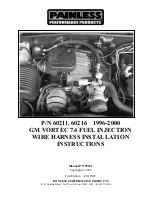
Never connect any trailer lighting to the vehicle’s taillamp
circuits, because it may damage the electrical system resulting in
fire. Contact your authorized dealer for assistance in proper trailer tow
wiring installation. Additional electrical equipment may be required.
Driving while you tow
When towing a trailer:
•
Keep your speed no faster than 70 mph (112 km/h) during the first
500 miles (800 km) of towing a trailer, and don’t make full throttle
starts.
•
Turn off the speed control. The speed control may shut off
automatically when you are towing on long, steep grades.
•
Consult your local motor vehicle speed regulations for towing a trailer.
•
To eliminate excessive shifting, use a lower gear. This will also assist
in transmission cooling. (For additional information, refer to the
Driving with an automatic transmission
section in the
Driving
chapter.)
•
Under extreme conditions with large frontal trailers, high outside
temperatures and highway speeds, the coolant gauge may indicate
higher than normal coolant temperatures. If this occurs, reduce speed
until the coolant temperature returns to the normal range. Refer to
Engine coolant temperature gauge
in the
Instrument Cluster
chapter.
•
Anticipate stops and brake gradually.
•
Do not exceed the GCWR rating or transmission damage may occur.
Servicing after towing
If you tow a trailer for long distances, your vehicle will require more
frequent service intervals. Refer to your
Scheduled Maintenance
Information
for more information.
Trailer towing tips
•
Practice turning, stopping and backing up before starting on a trip to
get the feel of the vehicle trailer combination. When turning, make
wider turns so the trailer wheels will clear curbs and other obstacles.
•
Allow more distance for stopping with a trailer attached.
•
If you are driving down a long or steep hill, shift to a lower gear. Do
not apply the brakes continuously, as they may overheat and become
less effective.
2006 Explorer
(exp)
Owners Guide (post-2002-fmt)
USA
(fus)
Tires, Wheels and Loading
204
















































